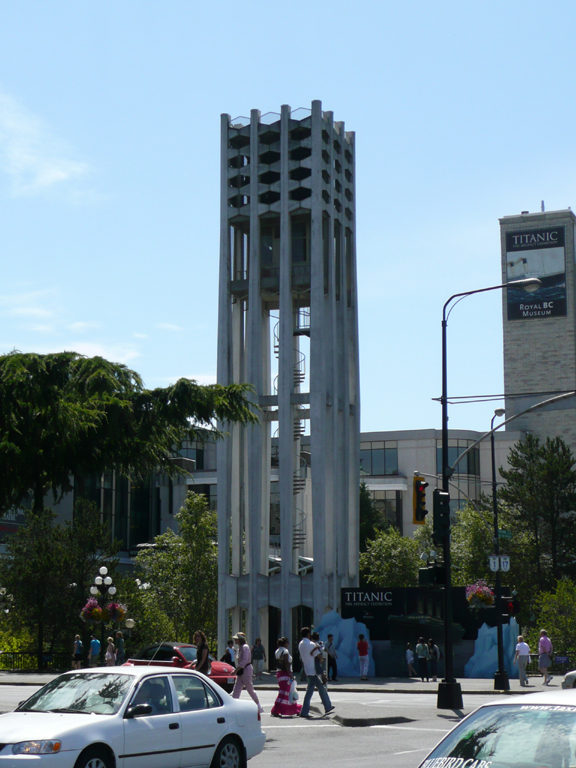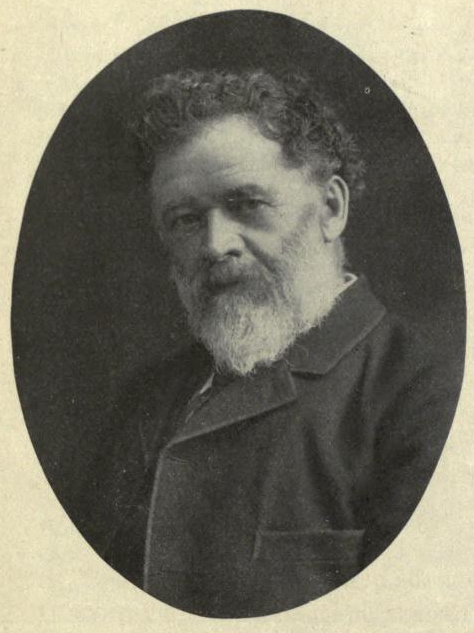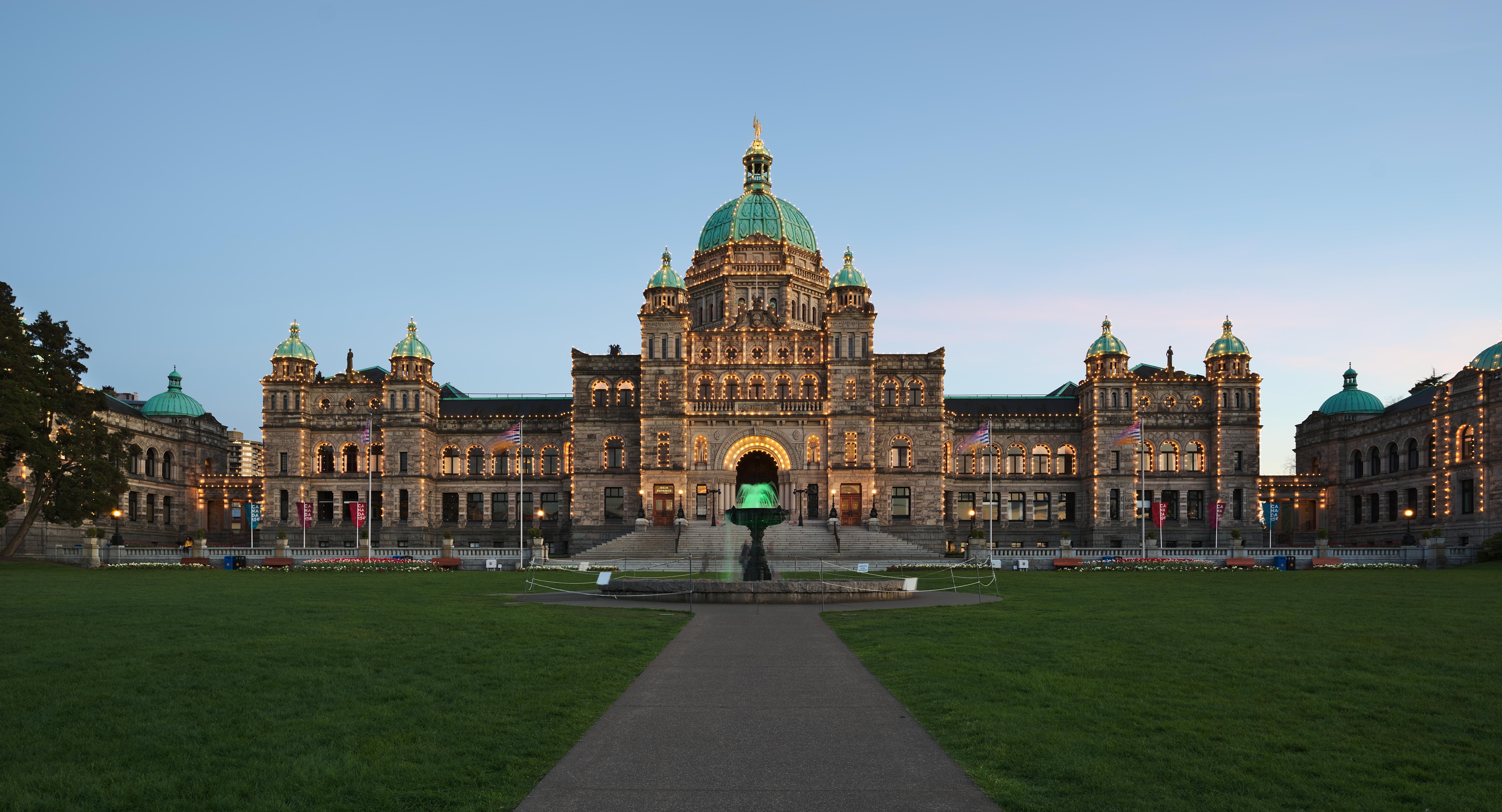|
Royal BC Museum
Founded in 1886, the Royal British Columbia Museum (sometimes referred to as Royal BC Museum) consists of The Province of British Columbia's natural and human history museum as well as the British Columbia Provincial Archives. The museum is located in Victoria, British Columbia, Canada. The "Royal" title was approved by Queen Elizabeth II and bestowed by HRH Prince Philip in 1987, to coincide with a Royal tour of that year. The museum merged with the British Columbia Provincial Archives in 2003. The Royal BC Museum includes three permanent galleries: Natural History, Becoming BC, and the First Peoples Gallery. The museum's collections comprise approximately 7 million objects, including natural history specimens, artifacts, and archival records.2010-11 Annual Report, p. 40 The natural history collections have 750,000 records of specimens almost exclusively from BC and neighbouring states, provinces, or territories. The collections are divided into eight disciplines: Entomology, B ... [...More Info...] [...Related Items...] OR: [Wikipedia] [Google] [Baidu] |
Victoria, British Columbia
Victoria is the capital city of the Canadian province of British Columbia, on the southern tip of Vancouver Island off Canada's Pacific coast. The city has a population of 91,867, and the Greater Victoria area has a population of 397,237. The city of Victoria is the 7th most densely populated city in Canada with . Victoria is the southernmost major city in Western Canada and is about southwest from British Columbia's largest city of Vancouver on the mainland. The city is about from Seattle by airplane, seaplane, ferry, or the Victoria Clipper passenger-only ferry, and from Port Angeles, Washington, by ferry across the Strait of Juan de Fuca. Named for Queen Victoria, the city is one of the oldest in the Pacific Northwest, with British settlement beginning in 1843. The city has retained a large number of its historic buildings, in particular its two most famous landmarks, the Parliament Buildings (finished in 1897 and home of the Legislative Assembly of British Columbia ... [...More Info...] [...Related Items...] OR: [Wikipedia] [Google] [Baidu] |
Matthew Baillie Begbie
Sir Matthew Baillie Begbie (9 May 1819 – 11 June 1894) was a British lawyer, politician, and judge. In 1858, Begbie became the first Chief Justice of the Crown Colony of British Columbia in colonial times and in the first decades after British Columbia joined Confederation as a province of Canada. Begbie served as the first Judge of the Supreme Court, Colony of British Columbia 1858 to 1866 and then, in the same capacity in the Supreme Court, the United Colonies of Vancouver Island and British Columbia from 1866 to 1870. He was Chief Justice of the Supreme Court of the United Colonies from 1870 to 1871 and then served as the first Chief Justice of the Supreme Court of the new Province of British Columbia from 1871 until his death on June 11, 1894. In the years after his death, Begbie came to be known as the Hanging Judge. Early life and education The son of an Army Colonel, Begbie was born on a British ship en route to the island of Mauritius, where he lived until he was ... [...More Info...] [...Related Items...] OR: [Wikipedia] [Google] [Baidu] |
Thunderbird Park (Victoria)
Thunderbird Park is a park in Victoria, British Columbia next to the Royal British Columbia Museum. The park is home to many totem poles (mostly Gitxsan, Haida, and Kwakwaka'wakw) and other First Nation monuments. The park takes its name from the mythological Thunderbird of Indigenous North American cultures which is depicted on many totem poles. Also in the park are St. Anne's Schoolhouse (built 1844), Helmcken House (built in 1852 by Dr. John Helmcken), and Mungo Martin House (''Wawadit'la''), a traditional Kwakwaka'wakw "big house" built in 1953 by Kwakwaka'wakw Chief Mungo Martin. The park is part of the Royal BC Museum Cultural Precinct, an area around the museum that contains a number of historical sites and monuments. History Totem poles were first erected on the site in 1940 as part of a conservation effort to preserve some of the region's rapidly deteriorating Aboriginal art. The site was opened as Thunderbird Park in 1941. By 1951, many of the poles had greatly d ... [...More Info...] [...Related Items...] OR: [Wikipedia] [Google] [Baidu] |
Netherlands Centennial Carillon
The Netherlands Centennial Carillon is a 62-bell carillon located in Victoria, British Columbia, Canada. Its tower is located at the intersection of Government Street and Belleville Street, in front of the Royal British Columbia Museum and across the street from the Parliament Building. It was given by the Dutch community of British Columbia in thanks for Canada's role in the liberation of the Netherlands during World War II. Queen Juliana of the Netherlands unveiled its cornerstone in 1967, Canada's centennial year. The carillon officially opened in May 1968. Its first 49 bells were cast at the Royal Bell Foundry by Petit & Fritsen at Aarle-Rixtel, in the Netherlands. Another thirteen were added in 1971.Humphreys, Dana, "Why the Bells Tolls", Focus Victoria's Magazine of People, Ideas and Culture, August 2007, page 56 See also * List of carillons Carillons, musical instruments of bells in the percussion family, are found on every inhabited continent. The Netherlands, ... [...More Info...] [...Related Items...] OR: [Wikipedia] [Google] [Baidu] |
Sisters Of Saint Ann
The Sisters of St. Anne (S.S.A.) is a Roman Catholic religious institute, founded in 1850 in Vaudreuil, Quebec, Canada, by the Blessed Marie Anne Blondin, S.S.A., to promote the education of the rural children of the Province of Canada. Their vision is rooted and guided by Ignatian spirituality. Foundation Esther Blondin (1809-1890) was the daughter of simple farmers in the village of Terrebonne, Quebec. Through her work as a domestic servant to the teaching Sisters of the Congregation of Notre Dame of Montreal who had opened a parochial school in the town, she came to learn how to read and write. She was accepted to the novitiate of the Sisters in 1833, but soon had to leave for reasons of health. Later that same year, having recovered her health, Blondin accepted the invitation from another former novice of the Congregation, who was running a parochial school in Vaudreuil, to join her in teaching there. Within a few years, she had become the principal of the school, then kno ... [...More Info...] [...Related Items...] OR: [Wikipedia] [Google] [Baidu] |
Helmcken House
Helmcken House is a museum in Victoria, British Columbia, located in Thunderbird Park. It was built by Dr. John Sebastian Helmcken, the first doctor in Victoria, in 1852, a surgeon with the Hudson's Bay Company. It is one of the oldest houses in British Columbia British Columbia (commonly abbreviated as BC) is the westernmost province of Canada, situated between the Pacific Ocean and the Rocky Mountains. It has a diverse geography, with rugged landscapes that include rocky coastlines, sandy beaches, .... Some interesting items on display include his medical kit. See also * Statue of John Sebastian Helmcken References External linksHelmcken Housefrom BC Heritage Branch. History of Victoria, British Columbia Houses completed in 1852 Museums in Victoria, British Columbia Historic house museums in British Columbia 1852 establishments in the British Empire {{Canada-museum-stub ... [...More Info...] [...Related Items...] OR: [Wikipedia] [Google] [Baidu] |
Jim Pattison
James Allen Pattison (born October 1, 1928) is a Canadian business magnate, investor, and philanthropist. He is based in Vancouver, British Columbia, where he holds the position of chief executive officer, chairman and sole owner of the Jim Pattison Group, Canada's second largest privately-held company, with more than 45,000 employees worldwide, and annual sales of $10.1 billion. The Group is active in 25 divisions, according to Forbes, including packaging, food, and forestry products. In 2015, he was considered to be Canada's fourth richest person. According to Forbes, Pattison's net worth in late 2018 was $5.7 billion, having increased substantially from the $2.1 billion reported in March 2009. At the time, he was described as Canada's third richest man by Bloomberg News. Pattison was inducted into Canada's Walk of Fame in December 2018, having previously been appointed to the Order of Canada (1987) and the Order of British Columbia (1990), and receiving the Governor General ... [...More Info...] [...Related Items...] OR: [Wikipedia] [Google] [Baidu] |
Rolls-Royce Phantom V
The Rolls-Royce Phantom V is a large four-door limousine produced by Rolls-Royce Limited from 1959 to 1968. Based on the Silver Cloud II, it shares a V8 engine and General Motors Hydra-Matic automatic gearbox with that model. Rolls-Royce assembled the cars' chassis and drivetrains with bodies made to standard designs by coachbuilders Park Ward and James Young, former vendors absorbed by Rolls-Royce. The engine is a 6,230 cc 90-degree V8 with twin SU carburettors, coupled to a 4-speed automatic transmission. The car has massive drum brakes and a wheelbase of 3,683 mm. Power assisted steering was standard. A shallow gear gave a walking speed which was suitable for ceremonies. From 1963 onward, the Silver Cloud III's 7% more powerful engine and new front wings (incorporating the latter's quad headlamps) were fitted. Park Ward vs James Young models Of the 832 total built between 1959 and 1968, James Young made 217 bodies. Park Ward, owned by Rolls-Royce, made 607 ... [...More Info...] [...Related Items...] OR: [Wikipedia] [Google] [Baidu] |
Canadian Centennial
The Canadian Centennial was a yearlong celebration held in 1967 to celebrate the 100th anniversary of Canadian Confederation. Celebrations in Canada occurred throughout the year but culminated on Dominion Day, July 1, 1967. Commemorative coins were minted, that were different from typical issues with animals on each — the cent, for instance, had a dove on its reverse. Communities and organizations across Canada were encouraged to engage in Centennial projects to celebrate the anniversary. The projects ranged from special one-time events to local improvement projects, such as the construction of municipal arenas and parks. The Centennial Flame was also added to Parliament Hill. Children born in 1967 were declared Centennial babies. Centennial projects Under the Centennial Commission, convened in January 1963, various projects were commissioned to commemorate the Centennial year. The prime minister, Lester Pearson, appointed in 1965 a committee headed by Ernest Côté t ... [...More Info...] [...Related Items...] OR: [Wikipedia] [Google] [Baidu] |
Royal Museum Front
Royal may refer to: People * Royal (name), a list of people with either the surname or given name * A member of a royal family Places United States * Royal, Arkansas, an unincorporated community * Royal, Illinois, a village * Royal, Iowa, a city * Royal, Missouri, an unincorporated community * Royal, Nebraska, a village * Royal, Franklin County, North Carolina, an unincorporated area * Royal, Utah, a ghost town * Royal, West Virginia, an unincorporated community * Royal Gorge, on the Arkansas River in Colorado * Royal Township (other) Elsewhere * Mount Royal, a hill in Montreal, Canada * Royal Canal, Dublin, Ireland * Royal National Park, New South Wales, Australia Arts, entertainment, and media * ''Royal'' (Jesse Royal album), a 2021 reggae album * ''The Royal'', a British medical drama television series * ''The Royal Magazine'', a monthly British literary magazine published between 1898 and 1939 * ''Royal'' (Indian magazine), a men's lifestyle bimonthly * Royal ... [...More Info...] [...Related Items...] OR: [Wikipedia] [Google] [Baidu] |
John Fannin
John Fannin (July 27, 1837 - June 20, 1904) was a Canadian naturalist, museum curator and explorer. A shoemaker who joined the gold rush and returned to become a taxidermist. He also surveyed parts of British Columbia and several places including Fannin Range, Fannin Lake, and Fannin Creek are named after him. ''Ovis fannini'' was named after him but it is now considered a color variant of the Dall sheep ''Ovis dalli''. Fannin was born in Kemptville, Ontario to William Fannin, tailor, and Eliza, who were of Irish origin. He may have taught at schools like his sister but little is known of his early life. He was a shoemaker for a while before joining the gold rush in British Columbia. He joined Thomas McMicking and they traveled overland through Fort Garry and Fort Edmonton to reach Kamloops through difficult terrain. Several men died and Fannin had to rely on his knowledge of the wilderness and survival skills to live with almost nothing. His attempts at mining and ranching in th ... [...More Info...] [...Related Items...] OR: [Wikipedia] [Google] [Baidu] |
British Columbia Parliament Buildings
The British Columbia Parliament Buildings are located in Victoria, British Columbia, Canada, and are home to the Legislative Assembly of British Columbia. The Speaker and the Serjeant-at-Arms are amongst those responsible for the legislative precinct, which by statute include the Parliament Buildings and grounds. The Neo-baroque buildings face north on Belleville Street facing the Inner Harbour and diagonally across from The Empress Hotel. A statue of Queen Victoria stands on the front lawn as well the British Columbia Legislature Cenotaph commemorating the province's World War I, World War II, Korean War and Afghanistan War dead. Atop the central dome is a gold-covered statue of Captain George Vancouver. Free guided tours of the facility are offered year-round. History From 1856 to 1860 the Legislature of the Colony of Vancouver Island met at Bachelor's Hall at Fort Victoria. From 1860 to 1898 it was housed in the first permanent building at Legislative Hall or Legislat ... [...More Info...] [...Related Items...] OR: [Wikipedia] [Google] [Baidu] |

_VICTORIA_FROM_JAMES'_BAY_LOOKING_UP_GOVERNMENT_STREET.jpg)




